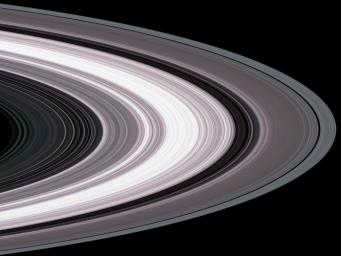Specially designed Cassini orbits place Earth and Cassini on opposite sides of Saturn's rings, a geometry known as occultation. Cassini conducted the first radio occultation observation of Saturn's rings on May 3, 2005.
Three simultaneous radio signals of 0.94, 3.6, and 13 centimeter wavelengths (Ka-, X-, and S-bands) were sent from Cassini through the rings to Earth. The observed change of each signal as Cassini moved behind the rings provided a profile of the distribution of ring material as a function of distance from Saturn, or an optical depth profile.
This simulated image was constructed from the measured optical depth profiles. It depicts the observed ring structure at about 10 kilometers (6 miles) in resolution. Color is used to represent information about ring particle sizes in different regions based on the measured effects of the three radio signals.
Shades of purple, primarily over most of the inner ring (ring B) and the inner portion of the next ring (ring A), indicate regions where there is a lack of particles less than 5 centimeters (about 2 inches) in diameter. Green and blue shades indicate regions where there are particles of sizes smaller than 5 centimeters (2 inches) and 1 centimeter (less than one third of an inch), respectively, primarily in outer ring A and within most of ring C. From other evidence in the radio observations, all ring regions appear to be populated by a broad range of particle size distribution that extends to boulder sizes (several to many meters or yards across).
The Cassini-Huygens mission is a cooperative project of NASA, the European Space Agency and the Italian Space Agency. The Jet Propulsion Laboratory, a division of the California Institute of Technology in Pasadena, manages the mission for NASA's Science Mission Directorate, Washington, D.C. The Cassini orbiter was designed, developed and assembled at JPL. The radio science team is based at JPL.
For more information about the Cassini-Huygens mission visit http://saturn.jpl.nasa.gov. For more information on the radio science team visit http://saturn.jpl.nasa.gov/spacecraft/instruments-cassini-rss.cfm.

 Planetary Data System
Planetary Data System












